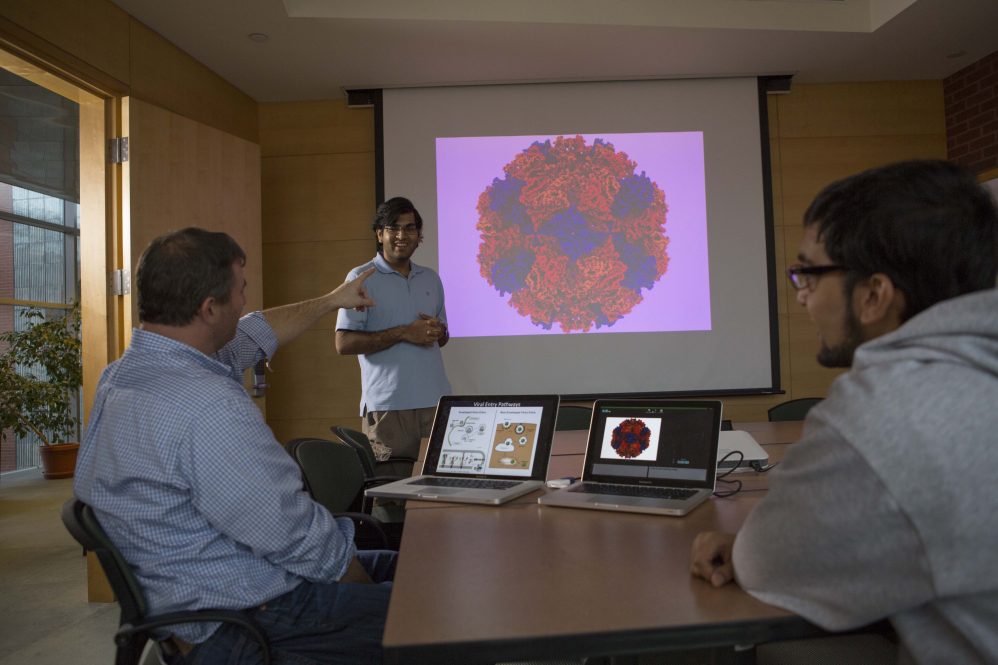Viruses sneak into your body, hijack your cells’ machinery, and force your cells to commit suicide. Sounds like a mission from a game like Assassin’s Creed, but it’s just a virus’s daily life. Now a UConn biophysics lab has figured out how one type of virus slips into our cells—and perhaps how we can stop them.
For a virus, infiltrating a human cell is a multistep process. In UConn computational biologist Eric May’s lab, they model the steps of infection using computer simulations to see how the virus does it, and whether there are any weak points where we can sabotage it. Such work requires heavy duty computing power; May’s lab uses supercomputers containing graphical processing units (aka GPUs, the kind used in gaming systems like the Xbox).
May and a former researcher in his lab, Asis Jana, currently a postdoctoral researcher at the University of Oklahoma, recently completed a study on Flock House Virus (FHV), published April 14 in Science Advances. FHV itself doesn’t actually infect humans, but it’s related to other viruses that do threaten human health such as polio and coxsackie virus. Because FHV is safe to study in labs, scientists have a very good portrait of the virus: its shape, its proteins, and the way its molecules move in simple situations.
But infecting a cell isn’t simple—it’s complicated, requiring many rather complex molecular events to happen. To understand how the process works, May’s lab wanted to look at the virus right at the point when a cell has “eaten it,” locking it inside a compartment called an endosome. How does the virus get out of the endosome?
This video shows the FHV virus when its trapped inside an endosome. Endosomes help sort proteins and other molecules in the cell. The endosome has an acidic environment inside, which helps groups of molecules separate from each other so they can be individually sorted to the right place. But FHV and many related viruses exploit that acidic environment. They use the acidity to open up a hole in a corner of their shell. That’s what’s happening in the video above. That little yellow squiggle you see peeking out of the shell? That’s important. See this next video:
That hole in the virus’s shell now opens wide enough for the yellow squiggle to come out entirely. The squiggle is actually a small protein that acts like a knife to slice open the endosome’s membrane and set the virus free to invade the cell. Achievement unlocked.
What’s so interesting about these videos is not just that they show how the virus works. It’s that this complex viral behavior emerges from a tiny package of proteins with no brain and no nervous system. Everything that happens in the video is due to random fluctuations between molecules, made more or less likely by the environment. The simulations done by May’s lab are based on physical models called molecular dynamics simulations, and have to be run for a very long time—hundreds of hours—in order to see the important (and unlikely) events happen. May uses advanced simulation techniques called enhanced sampling to increase the probability of “seeing” these rare events. Not only does this show how hard it is to study viruses at the molecular level, it also shows why just being exposed to a single virus particle rarely results in infection. A whole series of statistically unlikely events have to go just right in order for a virus to infect you. And yet, it happens all the time.
As May explains, that means that finding an intervention that would block one or more of those statistically unlikely events from happening could stop viral infections in their tracks. It wouldn’t have to work all the time; just stopping some of those events some of the time could tip the balance in our favor.
Right now, May’s lab is analyzing the process to find targets for drugs that could make the virus’s shell more stable, preventing the protein knife from emerging. The virus would never emerge from the endosome to invade the cell. Game over.



